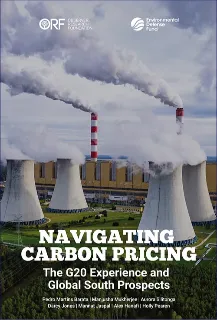The Context for Carbon Pricing in the G20: Benefits and Challenges
Why Put a Price on Carbon?
Climate change is widely recognised as a consequence of both market[1] and policy failures.[2] The failure to account for the costs of greenhouse gas (GHG) emissions in the prices of goods and services can be described as a fundamental market failure which has effectively allowed economic actors to exploit the atmosphere as a free resource, encouraging a continued link between fossil fuel consumption and economic growth.[3] Another significant factor driving climate change is policy failure in the form of fossil fuel subsidies and a distortionary tax system that incentivises emissions over environment protection.[4]
Carbon pricing is a well-established economic instrument which can internalise the cost of carbon dioxide emissions in goods and services and, by effect, optimally drive down the costs associated with reducing emissions.[5] Carbon pricing is a cost imposed on units of carbon emitted, or a proxy for such emissions—in theory, it incentivises polluters to decrease the volume of carbon that they release into the atmosphere. Through this approach, carbon pricing aims to redirect both the production and consumption patterns towards activities with lower carbon intensity and stimulate advancements in technology. Carbon pricing can take various forms, typically, carbon taxes or carbon trading markets.
The concept of internalising externalities, first introduced by economist Arthur Pigou in The Economics of Welfare (1920), is underpinned by the argument that individuals and firms tend to disregard the costs imposed on others unless those costs are reflected in their own actions. In this context, a Pigouvian tax on carbon serves as a mechanism to ensure that the costs of emitting GHGs are included in the prices of goods and services.[6] This approach was later popularised by Yale University economist William Nordhaus in the 1970s, who argued for assigning a monetary value to the environmental damage caused by GHG emissions, including carbon.[7] Today, it is generally recognised that carbon pricing is important and potentially useful but not a silver bullet and should be complemented with other fiscal policy and mitigation instruments to address market deficiencies and foster innovation while facilitating the adoption of low-carbon technologies.[8]
Potential Benefits of Carbon Pricing
Carbon pricing serves multiple purposes, each contributing to its importance as a policy tool.
The first aim is to correct market failures. By placing a price on carbon, businesses and individuals are incentivised to reduce their emissions, thereby enhancing economic efficiency. This incentive is based on an opportunity cost and is maintained throughout the operation of the carbon pricing system, whether a particular entity reduces its emissions to comply with a cap or decides to purchase allowances or credits to meet its obligation.
Additionally, carbon pricing mechanisms can play a vital role in stimulating investments in low-carbon technologies, renewable energy sources, and energy-efficient practices. Especially when carbon pricing mechanisms are designed to provide medium-term price signals, carbon pricing can promote investment stability and investor confidence, allowing finance to flow towards emission-saving technologies or solutions and encouraging the development of new emission-reducing practices. This not only contributes to a more sustainable future but also fosters innovation, promotes job creation, and spurs economic growth in green sectors.[9] Studies suggest that investments in sustainable industries have the potential to generate three times as many jobs compared to government spending in the fossil fuel sector.[10] In the context of developing economies, such investments take on greater significance as they support vulnerable sectors and communities in adapting to climate change and achieving just transitions.
Furthermore, carbon pricing can generate substantial revenue for governments, which can be allocated to support climate-related initiatives and regional and social transitions or be redistributed to citizens through dividends or tax cuts, thereby fostering public support for emission reduction efforts.[11] The World Bank’s State and Trends of Carbon Pricing 2023 report highlighted that the heightened ambition and broader application of carbon pricing mechanisms have led to a fivefold increase mechanisms have led to a fivefold increase in government revenues over the past decade.[12] Notably, this revenue surge has seen 40 percent of the funds being allocated to environment-friendly expenditures, while an additional 10 percent has been directed to compensating households and businesses.[13] The European Union emissions trading system (EU ETS) has helped generate over 152 billion euros for the government while reducing emissions by 35 percent since 2005.[14] Initially, revenue from the EU ETS was not allocated to specific ends, with only a general indication at the European level that member states should prioritise expenditure in social transition and innovation. Over time, this policy has changed, with increasing shares of revenues being committed at the EU level for innovation and social cohesion. At the national level, member states have equally tended to earmark revenue to specific policies, such as adaptation infrastructure, technological innovation, and socially just transitions.
Carbon Pricing in Action
Mandatory carbon pricing has been put into practice primarily through two mechanisms. The first is a carbon tax, in which the government imposes a tax on carbon emissions or a proxy thereof, such as the carbon content of fossil fuels.[15] Scandinavian nations were among the pioneers in implementing these carbon levies. In 1990, Finland became the first country to introduce a carbon tax, followed by Denmark, the Netherlands, Norway, and Sweden. In the last 30 years, several countries, including Argentina, Chile, Colombia, France, Germany, Japan, Mexico, Poland, Portugal, Singapore, South Africa, and Uruguay, have initiated carbon taxation policies in one or more economic sectors. Additionally, numerous regional entities, such as the Canadian provinces of Alberta, British Columbia, and Quebec, have implemented their own carbon taxation measures.[16]
The second approach is through an emissions trading system (ETS), or carbon market, which imposes emission limits on economic agents and allows such entities to trade emissions allowances, thereby creating a market-based price for carbon.[17] Trading allows entities within the ETS to decide whether to reduce emissions or to purchase emission allowances from other entities which may have a surplus or an overall lower cost to emission abatement. In this way, the overall cost of abatement is efficiently minimised across the participating economic actors, and emissions stay within the overall mandated limits. In 2005, the EU initiated the world’s inaugural carbon emissions trading system, building on previous experience in the US in the control of criteria pollutants, in particular sulphur dioxide. This EU ETS market is characterised by annual emission caps and pricing determined by the interplay of supply and demand for allowances. Comparable emissions trading mechanisms have since been adopted in Canada, China, South Korea, the United Kingdom, and several states of the United States (US).[18]
According to the World Bank, the percentage of global emissions subject to carbon taxes and emissions trading systems increased from 7 percent in 2005 to some 23 percent in 2023. The same report states that there are 73 carbon pricing instruments currently in operation covering 23 percent of global emissions.[19]
In parallel with developments in these compliance instruments, the world has also seen the emergence of a global voluntary carbon market, wherein companies seeking to decarbonise in line with the objectives of the United Nations (UN) Paris Agreement commit to long-term reduction pathways and purchase carbon credits generated by emission reduction projects and activities.
Finally, companies have also increased their use of implicit (or shadow) carbon pricing in their decision-making. This implies incorporating a carbon price (usually related to the social cost of carbon or to a metric similar to the longer-term carbon price in the prevailing sector in which the company operates) into investment calculations. By doing so, a company can best align its internal investment and operational decisions with the goals of the Paris Agreement.
These carbon pricing instruments are further explored in Chapter 2.
Context for Carbon Markets in the G20 Countries
The concept of carbon pricing offers a spectrum of benefits, with three core advantages. First, it promotes sustainable growth by incentivising cleaner and more energy-efficient practices, thereby fostering an environmentally responsible economy. Second, it serves as a magnet for investments, attracting capital for renewable energy projects and technology innovations that drive environmental progress. Third, carbon pricing contributes to substantial emission reductions, steering societies toward a lower-carbon future.[20]
However, alongside these benefits come a series of challenges that must be carefully addressed. For one, equity concerns are paramount throughout emissions mitigation policies. To avoid inequity, carbon pricing mechanisms need to be designed in ways that do not disproportionately burden vulnerable or marginalised populations.[1] Ensuring industrial competitiveness is another challenge, as businesses need to remain competitive in a global market while undergoing the transition to cleaner practices. Additionally, the effective design and implementation of carbon pricing policies is crucial to maximise their potential benefits and minimise unintended consequences. Balancing these benefits and challenges is essential for achieving a successful and equitable carbon pricing strategy.[21]
Despite these challenges, the benefits of carbon pricing make a compelling case for carbon pricing mechanisms, particularly within the G20 countries, which account for over 80 percent of global GHG emissions.[22] Mitigation instruments such as carbon pricing will prove to be a useful addition to the fiscal policy toolkit to reduce emissions as well as augment revenues.[23] There is growing recognition among the G20 countries of the imperative to transition towards net-zero GHG emissions to mitigate the existential dangers associated with climate change. Many nations have taken proactive steps by setting ambitious targets for reducing emissions. The implementation of carbon pricing measures can serve as a highly effective means to accelerate progress and attain the renewable-energy and energy-efficiency interim goals set for 2030.
| About the G20 The Group of Twenty (G20) is the premier forum for international economic cooperation. It plays an important role in shaping and strengthening global architecture and governance on crucial international economic issues. The G20 comprises 19 countries (Argentina, Australia, Brazil, Canada, China, France, Germany, India, Indonesia, Italy, Japan, Republic of Korea, Mexico, Russia, Saudi Arabia, South Africa, Türkiye, United Kingdom, and United States) and two regional bodies (the European Union and the African Union—the latter of which became a member in September 2023). The G20 members account for 85 percent of global GDP, over 75 percent of global trade, and two-thirds of the world population.[24] |
The G20 nations encompass a wide range of economies, from highly industrialised to emerging markets. While these nations exhibit diverse economic structures, they share common values and objectives in addressing climate change and emissions reductions. Carbon markets, due to their flexibility and market-oriented mechanisms, offer an avenue for these economies to tailor carbon pricing policies that suit their specific contexts. Tailored policies can assist in achieving ambitious emission-reduction targets while promoting economic diversity, equity, and innovation. Furthermore, carbon markets can facilitate international collaboration by allowing emissions trading, enabling countries to work together in achieving these emission reduction targets. Looking ahead, 122 of the 195 Parties to the Paris Agreement[25] have indicated in their updated Nationally Determined Contributions (NDCs) that they are planning or considering the use of carbon pricing to meet their NDCs.
Experts from international organisations such as the International Monetary Fund (IMF)[26] have therefore called for a minimum agreement on levels of carbon pricing,[27] while the European Commission[28] addressed its counterparts in the G20, encouraging them to join in carbon pricing regimes. As per the World Bank’s High-Level Commission on Carbon Prices,[29] in order to adequately limit global warming, countries would need to establish a carbon price ranging from US$50 to US$100 per tonne by 2030. The IMF further proposed a three-tier price floor featuring a progressive schedule of minimum carbon prices, which starts with a price of US$25 per tonne for low-income countries, followed by US$50 per tonne for middle-income countries, and US$75 per tonne for high-income countries. In tandem with other mitigation policies, it is believed to hold the potential to achieve a 23-percent reduction in global emissions below baseline by 2030.[30] However, the median global carbon tax currently stands at US$26 per tonne, while the median cost of allowances within carbon-trading systems is US$20 per tonne. Meanwhile, the EU ETS price has fluctuated between 60 and 100 euros since 2018. This median price, resulting from both taxation and trading, exhibits substantial variations based on the level of development in individual countries.[31]
It is thus safe to say that carbon pricing levels in existing regimes are not currently commensurate to the task of aligning our trajectories with the 1.5°C limit. Why then should G20 countries consider carbon pricing as a policy tool?
First, G20 countries should use carbon pricing strategically for the service of more rapid decarbonisation of their economies as they build competitive economies geared for the global market. Carbon pricing policies can enhance the local and global competitiveness of manufacturing and industry. This will be particularly relevant as more consumers and countries move away from higher-carbon-intensive products to lower-carbon alternatives. Already, this energy transition is being felt and is upending global patterns in many sectors, such as automotives manufacturing.
Second, strategic fiscal policies that utilise the revenue generated from carbon pricing can help alleviate the initial economic costs associated with the adoption of carbon pricing schemes.
Nonetheless, the path towards increased adoption by G20 countries must be country-owned and sensitive to the particular challenges of carbon pricing adoption in fast-growing economies, including the need for robust institutional frameworks, capacity building, and addressing potential competitiveness and equity concerns. These challenges can and should be addressed in the design of domestic carbon pricing approaches if carbon pricing policies are to be effective, efficient, and equitable. As more countries across the Global South consider and implement carbon pricing mechanisms and participate in carbon markets, South-South policy diffusion and the sharing of experience and lessons learned may be particularly valuable in tailoring solutions to these challenges.
Read the report here.
Endnotes
[1] Note: `Vulnerable population’ refers to groups of people particularly susceptible to adverse impacts or risks associated with carbon pricing policies, such as low-income households, rural communities, Indigenous people, elderly and children, populations dependent on carbon-intensive industries, and those lacking access to alternative energy sources or located in areas prone to climate-related hazards. `Marginalised population’ refers to groups of people who are systematically disadvantaged due to social, economic, or political factors. Marginalised populations can overlap with vulnerable populations in the context of carbon pricing but also include groups facing discrimination based on race, ethnicity, gender, disability, sexual orientation, or socioeconomic status.
[1] Nicholas Stern, The Economics of Climate Change: The Stern Review (Cambridge: Cambridge University Press, 2007), https://doi.org/10.1017/CBO9780511817434
[2] Alex Bowen, The Case for Carbon Pricing (London: Grantham Research Institute on Climate Change and the Environment, Centre for Climate Change Economics and Policy, 2011), https://www.lse.ac.uk/granthaminstitute/publication/the-case-for-carbon-pricing/
[3] Rob Jackson et al., “Global Emissions Rebound to Pre-COVID Levels,” Scientific American, November 11, 2021, https://www.scientificamerican.com/article/global-emissions-rebound-to-pre-covid-levels/
[4] Bowen, The Case for Carbon Pricing
[5] United Nations Framework Convention on Climate Change, “About Carbon Pricing,” https://unfccc.int/about-us/regional-collaboration-centres/the-ciaca/about-carbon-pricing#:~:text=Carbon%20pricing%20curbs%20greenhouse%20gas,development%20compatible%20with%20climate%20protection
[6] Mannat Jaspal, “To Price or not to Price? Making a Case for a Carbon Pricing Mechanism for India,” ORF Occasional Paper, Observer Research Foundation, September 26, 2022, https://www.orfonline.org/research/to-price-or-not-to-price-making-a-case-for-a-carbon-pricing-mechanism-for-india
[7] Zeid Ra’ad Al Hussein and Farrukh Iqbal Khan, “The Case for a Global Carbon-Pricing Framework,” Foreign Affairs, September 11, 2023.
[8] Era Dabla-Norris et al., “Countries Must Contain Global Warming While Keeping Debt in Check,” IMF Blog, October 2, 2023, https://www.imf.org/en/Blogs/Articles/2023/10/02/countries-must-contain-global-warming-while-keeping-debt-in-check
[9] United Nations Framework Convention on Climate Change, “About Carbon Pricing”
[10] World Bank, State and Trends of Carbon Pricing 2021, Washington DC, World Bank Group, 2021, http://hdl.handle.net/10986/35620
[11] Jaspal, “To Price or not to Price? Making a Case for a Carbon Pricing Mechanism for India”
[12] World Bank, State and Trends of Carbon Pricing 2023: Executive Summary, Washington DC: World Bank Group, 2023, https://openknowledge.worldbank.org/server/api/core/bitstreams/f34bc312-dd6c-4add-ba80-069b5ac20d36/content
[13] World Bank, State and Trends of Carbon Pricing 2023, Washington DC, World Bank Group, 2023, http://hdl.handle.net/10986/39796
[14] “EU Commission Chief Asks G20 to Join Global Carbon Pricing,” Reuters, September 9, 2023, https://www.reuters.com/sustainability/eu-commission-chief-asks-g20-join-global-carbon-pricing-2023-09-09/
[15] United Nations Framework Convention on Climate Change, “About Carbon Pricing”
[16] Al Hussein and Iqbal Khan, “The Case for a Global Carbon-Pricing Framework”
[17] United Nations Framework Convention on Climate Change, “About Carbon Pricing”
[18] Al Hussein and Iqbal Khan, “The Case for a Global Carbon-Pricing Framework”
[19] World Bank, “State and Trends of Carbon Pricing 2023”
[20] Joseph E. Aldy and Robert N. Stavins, “The Promise and Problems of Pricing Carbon: Theory and Experience,” Journal of Environment & Development 21, no. 2 (2012): 152-80, https://doi.org/10.1177/1070496512442508
[21] Aldy and Stavins, “The Promise and Problems of Pricing Carbon: Theory and Experience”
[22] “G20 Economies are Pricing More Carbon Emissions but Stronger Globally More Coherent Policy Action is Needed to Meet Climate Goals, Says OECD,” OECD Web Archive, October 27, 2021.
[23] “EU Commission Chief Asks G20 to Join Global Carbon Pricing”
[24] G20 Secretariat, Ministry of External Affairs, Government of India, “About G20,” 2023, https://www.g20.org/en/about-g20/
[25] “Explore Nationally Determined Contributions (NDCs),” Climate Watch Data, https://www.climatewatchdata.org/ndcs-explore?category=mitigation&document=all&indicator=method_imm
[26] Jean Chateau et al., “Why Countries Must Cooperate on Carbon Prices,” IMF Blog, May 19, 2022, https://www.imf.org/en/Blogs/Articles/2022/05/19/blog-why-countries-must-cooperate-on-carbon-prices
[27] Chateau et al., “Why Countries Must Cooperate on Carbon Prices”
[28] “EU Commission Chief Asks G20 to Join Global Carbon Pricing”
[29] Carbon Pricing Leadership Coalition, Report of the High-Level Commission on Carbon Prices, Washington DC, World Bank Group, 2017, https://www.carbonpricingleadership.org/report-of-the-highlevel-commission-on-carbon-prices
[30] Vitor Gaspar and Ian Parry, “A Proposal to Scale Up Global Carbon Pricing,” IMF Blog, June 18, 2021, https://www.imf.org/en/Blogs/Articles/2021/06/18/blog-a-proposal-to-scale-up-global-carbon-pricing
[31] Al Hussein and Iqbal Khan, “The Case for a Global Carbon-Pricing Framework”
The views expressed above belong to the author(s). ORF research and analyses now available on Telegram! Click here to access our curated content — blogs, longforms and interviews.

 PDF Download
PDF Download



 PREV
PREV








